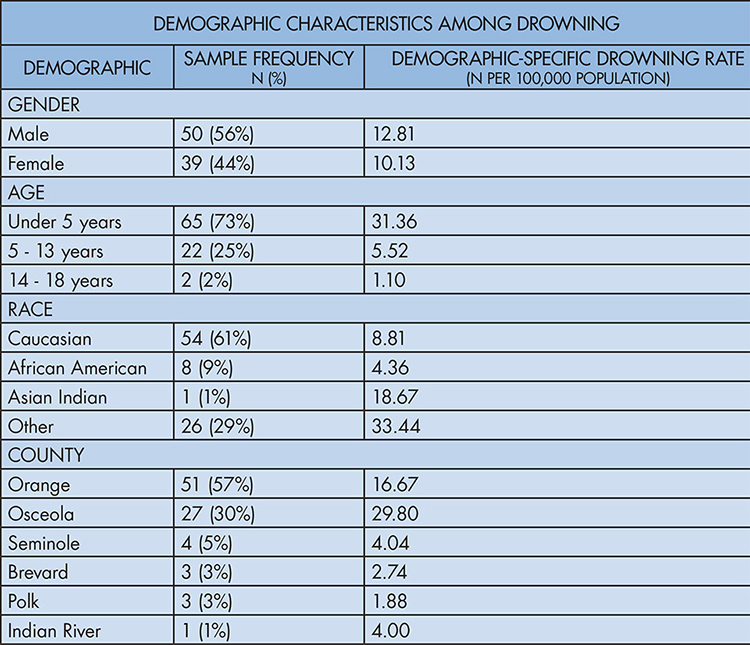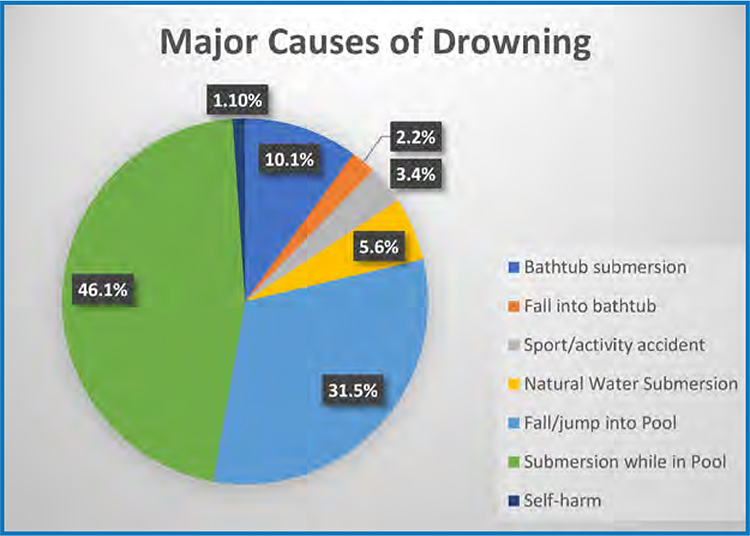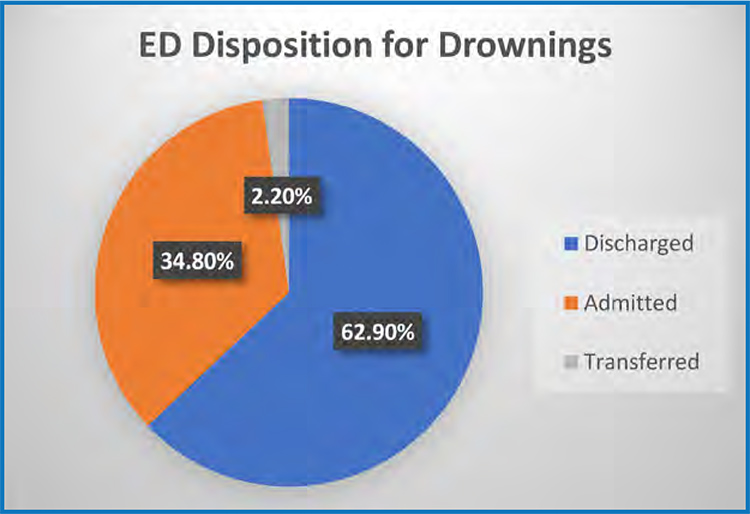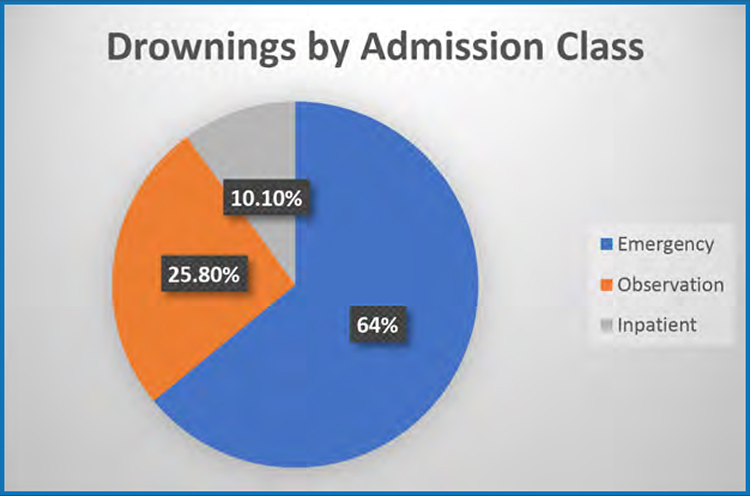Common Themes in Pediatric Drownings of Central Florida
AUTHORS:
Brianna Leone, MS41; Johanna Kielbasa, MD2; Corinne Bria, MD2
1 University of Central Florida College of Medicine
2 Nemours Children’s Hospital
Student Article | PUBLISHED Summer 2023 | Volume 43, Issue 3
DOWNLOAD PDF
Abstract
Background and Objectives
Drowning is a leading cause of preventable death in children, especially in Central Florida. Central Florida is a common destination for families, and with this vacationing population, drowning incidents are consistently increasing. Age, demographics, swimming proficiency, and lack of supervision have been shown to contribute to pediatric drownings. However, drowning literature lacks studies focusing on specific regions. This study aims to describe the causes of drowning in children presenting to Nemours Children’s Hospital in Central Florida. This data will be used to create educational interventions to reduce these incidents.
Methods
This study examined any child (birth to 18 years) presenting to Nemours Children’s Hospital of Central Florida who drowned and died or who drowned and survived. Patient charts were accessed through Epic, and demographic variables analyzed included zip code, sex, age, and race. This study also gathered data on the patient’s presenting history, length of stay, and extent of required treatment (ED, inpatient, or discharge).
Results
Deidentified data was analyzed through summative analyses of variables based on age group and location. Results showed that males under five years of age had the highest drowning rates, with a 2% mortality rate overall. Most children drowned in a pool, and the mean length of stay was 0.56 days.
Conclusions
The data collected gives insight into the causes of drowning within Central Florida and the population at most significant risk. Trends in drowning should be assessed with a larger population to appropriately create targeted interventions for this specific region.
Introduction
Drowning is one of the leading preventable causes of death in the pediatric population and a severe problem worldwide.1 The World Health Organization defines drowning as “the process of experiencing respiratory impairment from submersion/immersion in a liquid.”2 Drowning may occur from either submersion, when a victim’s airway is under the surface of water or immersion, when water splashes over a victim’s face.3 The CDC reported in 2014 that 1 in 5 drowning victims are aged 14 and younger.4 Children between the ages of 1 and 4 have the highest drowning rates, with 75% of pediatric drownings occurring in those under the age of five years.4 Due to their young age and need for constant supervision, children are at a higher risk for submersion injuries than the rest of the population.5 Research has shown that of pediatric patients admitted to the hospital for drowning and submersion injuries, the most common cause of death was either the withdrawal of life-sustaining treatment due to anoxic brain death or failed resuscitation after accidental injury leading to cardiac arrest.6
The Central Florida area is at significantly higher risk for drowning and submersion injuries due to being a popular travel destination for its proximity to multiple waterways and resorts. In a retrospective review completed in Tampa, Florida, a 6-fold increased risk for pediatric drowning was associated with visiting family or friends compared to the usual risk of drowning at a home pool.7 Lapses of supervision are associated with most childhood drownings, and this may be increased in specific populations.8 The Central Florida area is unique due to the high prevalence of water activities and tourism. It warrants further investigation for the causes of drowning accidents to prevent future injuries from occurring.
Sources focusing on drownings and near drownings in pediatric patients do exist. Drowning rates have been shown to differ based on sex, with males having a higher risk of injury than females.9 In one review, males were found to have an almost ten times higher risk for drowning than females the same age.10 Drowning has also been shown to differ in terms of race. White children have a higher likelihood of drowning in home swimming pools, and black children have a higher likelihood of drowning in oceans, ponds, or lakes.11 Regarding the age group, the highest drowning rate in the United States has been linked to the 0-4-year-old age group, with rates above 75%.3 Family socioeconomic status is another factor that has been shown to contribute to drowning deaths in pediatric patients. However, the information is not highly agreed upon, and this area of research is lacking in extensive studies. Some studies show that drowning rates are higher in low-income areas, while others have found that drowning risk is associated with higher incomes due to greater access to pool facilities.12,13
The current state of the literature regarding drowning is incomplete. While some sources discuss drowning cases, these sources are outdated and may not reflect current causes or demographic breakdown of drowning accidents in pediatric patients. Some sources have identified common risk factors and outcomes of pediatric drownings, but few sources discuss the combination of these factors. More analyses are needed to determine the link between sociodemographic information, causes of drownings, and outcomes. Therefore, the Central Florida area provides a significant population to be investigated to understand the regional differences that may exist to produce targeted interventions.
This research aims to determine the causes of drowning and the extent of medical interventions necessary for pediatric patients presenting to Nemours Children’s Hospital (NCH). This study will also examine sociodemographic factors of pediatric patients in central Florida who presented to NCH to produce an introductory region-based drowning analysis. It is hypothesized that drownings will vary based on the county, with Orange County having the most drownings in the Central Florida area, as presented to NCH. It is also hypothesized that young children (0-5 years) are at increased risk of drowning, with a leading cause being a lack of supervision.
This research is critical in saving the lives of pediatric patients in both traveling families and residents in Florida. More research is needed in drowning-related accidents to prevent more drownings from occurring in the future. This study aims to better understand pediatric drownings in Central Florida by analyzing demographic trends and causes of drowning accidents. The information obtained will create age-specific strategies and educational material/interventions to reduce drowning accidents in Central Florida’s pediatric population.
Methods
The population analyzed consisted of pediatric patients (ages 0-18 years) presenting to Nemours Children’s Hospital (NCH) who drowned or had a submersion accident in Central Florida. The Central Florida region (as analyzed in this study) includes the following counties: Brevard, Citrus, Hardee, Hernando, Hillsborough, Indian River, Lake Manatee, Marion, Orange, Osceola, Pasco, Pinellas, Polk, Seminole, Sumter, and Volusia.
All patients who met the above criteria and presented to NCH in Orlando, FL, within the past eight years (2013–2020) were included in this analysis with a total sample size of 89 patients. Patient data were obtained from the Epic electronic medical record database and queried by location using zip codes via an NCH data analyst. The results were filtered for the age range and type of injury, including drowning or submersion accidents. Patient charts were searched for demographic information, including race, gender, and age. Patient history of present illness was searched for chief complaint and a history of drowning.
The results were then deidentified and coded based on demographic variables, emergency department disposition, the cause of drowning injury (based on ICD code), patient admission class, and length of stay. The general results were analyzed by calculating the frequency of each variable within the study population. The drowning rate per 100,000 population was calculated to standardize the data compared to the census population. To calculate this, the sampling frequency for each demographic was divided by the total population of the same demographic and then multiplied by 100,000. The formula for demographic-specific drowning was N (Sample) / N (Census Population) x 100,000. For example, to calculate this rate for different age groups, the number of those under five within the study sample was divided by the number of those under five years of age in all counties included in the study, multiplied by 100,000. A similar calculation was used for gender and race. The number of patients in the sample from each county was divided by the census number of children 0-18 years in each county and similarly multiplied by 100,000 to standardize the data between counties.
This study was based on retrospective data analysis and used no human participants. IRB exemption was granted.
Results
This study population sample consisted of 89 pediatric patients with a drowning or near-drowning incident between 2013 and 2020. Of this population, there were two fatalities due to submersion. Therefore, the drowning mortality rate of this sample of pediatric patients presenting to Nemours Children’s Hospital was 2%. Of the two deaths included in this study, both patients were male. One patient was a 2-year-old black male who drowned in a pool without supervision. The other child was a 12-year-old white male who drowned in a bathtub after a possible seizure or syncopal episode.

Table 1: Pediatric Population Demographics
Table 1 presents the sociodemographic information for the sample studied. Column 1 lists the demographic categories observed, and column 2 shows frequency data as the number of patients and percent of patients for gender, age, race, and county. Column 3 is the calculated drowning rate per 100,000 population for each demographic subset. Table 1 shows that males were at a greater risk of drowning within the sample, with 50 of those who drowned, or 56% of the sample population, being male. Those under five years of age also had a higher risk of drowning, and 65 (73%) of the sample was under the age of 5 years. When this data was standardized according to the census population, the rate of drowning in males (12.81 per 100,000) and those under five years (31.36 per 100,000) remained the highest. The highest race that accounted for drowning within the sample population was the Caucasian race. However, after adjusting for the total population, the “other” race category had the highest drowning rate. This category included those of the America Indian, Asian, and Pacific Islander races, as well as those who had two or more races. In terms of the county, Orange County had the highest frequency of drownings within the study sample. However, after accounting for differences in the total population of each county, Osceola County had the highest rates of drowning, as seen in column 3.

Table 2: Descriptive Statistics of Pediatric Drownings
Table 2 shows descriptive statistics of the study that were assessed. The youngest age of drowning was 0 years, and the oldest was 14 years, with a mean of 3.58 years and a SD of 3.275. In terms of length of stay, the minimum length was 0 days (discharged right away), and the maximum was five days. The mean length of stay was 0.56 days with a SD of 0.865 days.

Figure 1: Etiology of Drowning Accidents

Figure 2: Drowning accident admission status

Figure 3: Admission class of drownings
Figures 1, 2, and 3 illustrate the findings for causes of drowning, ED disposition, and patients’ admission status, respectively. In Figure 1, pool drownings were found to be the most common. 46.1% of children had a submersion injury while in a pool (swimming and went under water for too long, slipping out of a floating device, etc.), and 31.5% of kids had an injury resulting from a jump or fall into the pool (jumping into water too deep, falling off the ledge or step, hitting head during jump). Bathtub drownings were the next most common cause of submersion injury, with 10.1% of children being submersed and 2.2% falling into a filled bathtub. Other causes of less common drowning included self-harm attempt, fall into natural water (lake or stream), and sport/activity accident (falling off watercraft, etc.).
Figure 2 illustrates the three possible outcomes of patient care once a patient was seen in the Emergency Department. Most children (62.9%) were discharged home on the same day of the accident, requiring little to no treatment. The most likely outcome after presenting was admission to the inpatient service for further care, with 35% of children needing a more extended stay. Some children (2%) were transferred to another location often due to parental requests or lack of available treatment.
Figure 3 shows the admission status of children presenting to Nemours Children’s Hospital after near drowning or drowning accidents. Most children (64%) needed emergency care, with the remaining staying only for an observation period (26%) or being admitted to the inpatient service (10%).
Discussion
The data collected through Nemours Children’s Hospital were based on a sample size of 89 patients. Analysis of the sample frequency data (Table 1) compared to data standardized for the census population showed that drowning is more prevalent amongst the younger age groups. Those aged 0-4 years were found to have the highest risk of drowning in the Central Florida region, and this data is consistent with nationwide drowning data.2 Many factors may contribute to the high prevalence of drowning accidents in this age group. One of the most likely reasons for the drowning of young children in this age group comes from a lack of supervision.5 Toddlers and small children are often highly interested in bodies of water such as pools and lakes, especially if there are toys or floating objects. Small children also have a higher risk of drowning because of their size, and children under two can drown in only a few inches of water due to a lack of gross motor control.14 The relationship between sex and drowning found in this study is like that found in other regions, with males having a higher risk of drowning than females.15 The cause of increased male drowning accidents is not thoroughly understood. Race was also found to have a unique relationship with drowning accidents in Central Florida. After standardizing the data to attribute for the census population data for race, the “other” race category had the highest drowning rates, indicating a cultural difference in water safety and drowning prevention.16
When analyzing the drowning data by county, Orange County was found to have the highest rates of drowning accidents within the study. However, after adjusting for the total population, Osceola County had the highest pediatric drowning rates. These two counties are known travel destinations for tourists due to their proximity to amusement parks, beaches, and other sites, which may have influenced the higher rates of accidents. More research is needed to determine the link between vacationers and drownings within this area. Proximity to Nemours Children’s Hospital likely contributes to the higher ED visits in Orange and Osceola counties.
The major causes of drowning, elucidated in Figure 1, were submersion while in a pool (46.1%) and submersion because of falling or jumping into a pool (31.5%). Within this population, 77% of drowning accidents occurred in a pool. Many pool accidents occur at the family residence, but they can also occur at community pools or vacation properties. There is often a lack of safety precautions present in the setting of pool drowning accidents. These unsafe measures include an open swimming pool gate, a gate latch at a child’s accessible height, unlocked doors, or doors without alarms.17 Some potential safety measures like pool covers have even been found to present a greater risk for children.18 The regional data shows that drownings can happen while caregivers are in the pool with the child. Many parents believe that drownings are obvious or that they would hear their child splashing for help.19 However, accident accounts have shown that children often drown silently within seconds to minutes, making supervision very important.18
When looking at outcomes of patients seen for drowning injuries, most patients (64%)
were discharged within the day with minor injuries. Of the remaining patients, 35% were admitted due to more severe lung complications and injuries, and 2% were transferred to another hospital at the request of parents or physicians. While most children were able to recover from their injuries, this data helps illustrate how the potential for morbidity in those involved in drowning accidents.
Several limitations existed throughout this study. Because this was a retrospective study, there was an inability to control for characteristics in the chosen study population. The study also only looked at patients presenting to Nemours Children’s Hospital in Orlando, which may be why many counties in the Central Florida were not accounted for in the results. For example, counties like Citrus, Hernando, and Hillsborough most likely also have a high rate of drowning accidents. However, due to the distance from NCH Orlando and the situation’s urgency, these children were not seen in Orlando and are therefore not accounted for in the study. As previously mentioned, the proximity of patients to Nemours Children’s Hospital most likely played a prominent role in the data in this study. Data from all regional hospitals would need to be included to find the accurate population frequencies. Lastly, the small sample size and focus on a specific regional area may have influenced the results. These results may change when applied to a larger population.
Future directions for this study exist, with plans to analyze data on patient drownings from all hospitals in Florida. The larger population will help expand this study’s findings and better inform others of the significant causes of drowning accidents. Hospital-wide data will also allow for a more accurate regional analysis. Analyzing data from other major hospitals will allow for a breakdown by county to show the most common areas for drowning accidents. The findings from this future study will be used to inform public health and Florida government officials. The results will also be used to create water safety programs and initiatives within the most affected areas. Once the drowning problem is understood, prevention strategies can be better implemented for hotels, vacation rentals, and pediatric offices.
Conclusion
Drowning and near-drowning events are a significant problem nationwide, and these accidents compose a leading cause of unintentional and preventable death within many different age groups. Florida has been shown to have some of the highest drowning rates among the states, especially within the pediatric population. Research in drowning is lacking, but the number of drowning accidents continues to rise. This analysis illustrates the need for targeted intervention strategies in the youth to prevent more common pool-based drownings and less common causes of drowning. Further research and efforts in promoting water safety are desperately needed to save children and help educate those at risk of drowning or submersion incidents.
References
- Loux T, Mansuri F, Brooks SE, et al. Factors associated with pediatric drowning admissions and outcomes at a Trauma Center, 2010–2017. Amer J Emerg Med. 2021;39:86-91.
- World Health Organization. https://www.who.int/news-room/fact-sheets/detail/drowning. Accessed October 6, 2022.
- Szpilman D, Bierens JJLM, Handley AJ, Orlowski JP. Drowning. NEJM. 2012;366(22):2102-2110.
- Drowning Prevention. Centers for Disease Control and Prevention. https://www.cdc.gov/safechild/drowning/index.html. Accessed October 6, 2022.
- Abelairas-Gomez C, Tipton MJ, Gonzalez-Salvado V, Bierens JJLM. Drowning: epidemiology, prevention, pathophysiology, resuscitation, and hospital treatment. Emergencias. 2019;31(4):270-280.
- Trowbridge A, Walter JK, McConathey E, Morrison W, Feudtner C. Modes of death within a children’s Hospital. Pediatrics. 2018;142(4).
- Orlowski JP, Cramer CL. The drowning risks associated with visiting family or friends. J Pediatr Intensive Care. 2012;1(1):31-35.
- Peden AE, Franklin RC. Causes of distraction leading to supervision lapses in cases of fatal drowning of children 0-4 years in Australia: A 15-year review. J Paediatr Child Health. 2020;56(3):450-456.
- Liu Z, Kong F, Yin L, Wang A, Xiong L, Xie D, et al. Epidemiological characteristics and influencing factors of fatal drowning in children under 5 years old in Hunan Province, China: case-control study. BMC Pub Health. 2019;19(1):955.
- Weiss J. American Academy of Pediatrics Committee on Injury, Violence, and Poison Prevention. Prevention of Drowning. Pediatrics. 2010;6(1): e253-62.
- Rowe MI, Arango A, Allington G. Profile of pediatric drowning victims in a water-oriented society. J Trauma. 1977;17(8):587-91.
- Peden MM, McGee K. The epidemiology of drowning worldwide. Inj Control Saf Promot. 2003;10(4):195-9.
- Morgenstern H, Bingham T, Reza A. Effects of pool-fencing ordinances and other factors on childhood drowning in Los Angeles County, 1990-1995. Am J Public Health. 2000;90(4):595-601.
- Brenner RA, Taneja GS, Haynie DL, et al. Association between swimming lessons and drowning in childhood: a case-control study. Arch Pediatr Adolesc Med. 2009;163(3):203-10.
- Spencer MR, Hedegaard H, Warner M. Unintentional drowning deaths among children aged 0-17 years: United States, 1999-2019. NCHS Data Brief. 2021;(413):1-8.
- Siano CJ, Messiah SE, Banan L, Arheart K, Pena B. Swimming proficiency in a multiethnic sample in a high-risk area for drowning. Arch Pediatr Adolesc Med. 2010;164(3):299-300.
- American Academy of Pediatrics Committee on Injury, Violence, and Poison Prevention; Prevention of Drowning. Pediatrics 2010;126 (1):178–185.
- Denny SA, Quan L, Gilchrist J, et al. Council on injury, violence, and poison prevention: Prevention of Drowning. Pediatrics. 2019;143(5): e20190850.
- Dowd MD. Dry drowning: myths and misconceptions. Pediatr Ann. 2017;46(10): e354-e357.
